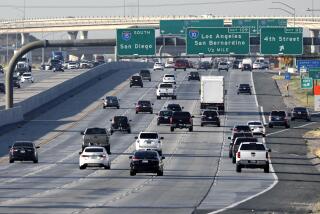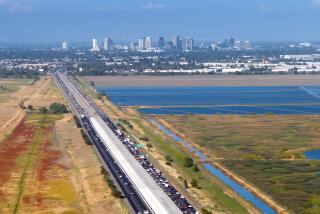It’s Gas Tax or Gridlock, SCAG Says
By the year 2010, average speeds on surface streets will drop to 11 miles per hour from the current 31 m.p.h. if current trends continue in Orange and surrounding counties, a regional planning agency predicts in a new draft report.
Average freeway speeds will drop from 47 m.p.h. to 27 m.p.h., according to the report. Half of commuter time will be spent in congestion. And motorists might have to pony up a $1 per gallon gasoline tax to correct the problem.
“There will be gridlock across the region unless we find a way out,” says the draft urban mobility study by the Southern California Assn. of Governments (SCAG). The draft study was presented Monday at a meeting of the Orange County Transportation Commission in Santa Ana.
Commission officials were hostile. “This report is like saying we need a new Mercedes,” said Commission Executive Director Stanley T. Oftelie. “But we feel we can’t afford it.”
4 Alternate Strategies
The report, a 20-year regional transportation plan, proposes four alterative strategies for coping with the traffic mess. Costing between $34 billion and $110 billion, all of the scenarios call for extensive commuter rail lines and thousands of miles of additional freeways. To build its way out of gridlock under these scenarios, Southern California motorists would have to pay “at least” an extra $1 a gallon tax on the gas they use, said Jim Gosnell, SCAG’s director of transportation.
Indeed, it was a nasty brew of taxes, rails and freeways that Gosnell stirred before a hostile commission, which voted to study the matter for 60 days while it also completes its own 20-year study due in late May.
“The things I see in here are revolutionary both politically and financially,” said commission Chairwoman Clarice A. Blamer, in one of the milder reactions Monday. “We need to get some realism in there.”
In 1984, Orange County voters overwhelmingly rejected Proposition A, a measure that would have added 1 cent to the existing 6% sales tax for the next 15 years to build $5 billion worth of new freeways, a 38-mile light-rail line and other transportation projects.
“The dollar per gallon gas tax doesn’t seem realistic to this commission,” Oftelie said following Monday’s meeting.
Commission member Roger R. Stanton bluntly dismissed the SCAG report.
“This is really pie in the sky,” he said, comparing the practicality of the scenarios to asking grunions to switch their migration from Huntington Beach to Newport Beach. “This plan is about as effective,” said Stanton.
Population Estimates
Stanton, who is also a county supervisor, questioned SCAG’s population growth projections--always disputed by county officials who come up with lower numbers--and SCAG’s ability to implement any plan in the first place.
SCAG is the regional planning agency for Orange, Los Angeles, Ventura, San Bernardino, Riverside and Imperial counties.
The 20-year draft transportation plan presented Monday, officially called a Regional Mobility Plan, is one of several long-term studies SCAG is preparing called Emerging Futures. These include housing, air quality, land-use and energy conservation issues in the Southland. All of the plans will be discussed before the public at a series of meetings this summer.
Under the $110-billion transportation scenario, more than 5,363 miles of new freeway and car-pool lanes would be built along with 20 railway corridors.
A second proposal, with expected construction costs of $87 billion, would add more than 6,000 new freeway and car-pool lanes and also 16 rail lines, but would require more shifting of new jobs closer to housing areas.
Mass-Transit Use
The third proposal, calling for 1,850 miles of new freeway and car-pool lanes with 18 rail lines at a cost of $42 billion, would shift jobs closer to homes, too, but also impose strict ride-sharing and mass-transit use requirements.
Under the fourth proposal, not yet complete, about 2,700 miles of new freeway and car-pool lanes would be added along with 20 rail lines but with no requirement to encourage closer siting of new jobs and housing. Like the third scenario, the fourth proposal calls for 80% of the region’s work force to go on a flexible work-shift schedule and includes stricter ride-sharing requirements. Capital costs would be about $56 billion.
After public review and modification, the proposed transportation alternatives will be shaped by SCAG into one recommendation with an environmental impact review in August.
Final adoption of a single plan--which may differ from any plan now proposed--is not expected to be approved by SCAG’s board of directors until January, 1989, Gosnell said. Under state law, the county commission must follow SCAG’s regional plan guidelines when allocating state or federal money for transportation projects.
More to Read
Sign up for Essential California
The most important California stories and recommendations in your inbox every morning.
You may occasionally receive promotional content from the Los Angeles Times.










